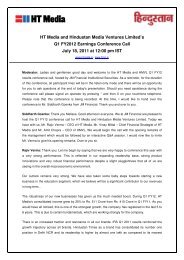Download latest annual report - HT Media
Download latest annual report - HT Media
Download latest annual report - HT Media
Create successful ePaper yourself
Turn your PDF publications into a flip-book with our unique Google optimized e-Paper software.
In respect of fixed assets (Plant & Machinery- printing<br />
press) acquired during the year 2004-05 from the<br />
holding company, depreciation is provided on straight<br />
line method over estimated useful life of 5 years as<br />
technically assessed by an independent expert.<br />
Assets costing below `5,000 each are fully depreciated<br />
in the year of acquisition.<br />
Leasehold Land is amortized on a straight line basis<br />
over the period of lease.<br />
Leasehold Improvements are amortized on a straight<br />
line basis over the useful life not exceeding 10 years or<br />
over the life of lease, whichever is lower.<br />
e) Intangibles<br />
Intangible assets acquired separately are measured on<br />
initial recognition at cost. Following initial recognition,<br />
intangible assets are carried at cost less accumulated<br />
amortization and accumulated impairment losses, if<br />
any. Internally generated intangible assets, excluding<br />
capitalized development costs, are not capitalized and<br />
expenditure is reflected in the statement of profit and<br />
loss in the year in which the expenditure is incurred.<br />
Value for individual software license acquired from the<br />
holding company in an earlier year is allocated based<br />
on the valuation carried out by an independent expert.<br />
Intangible assets are amortized on a straight line basis<br />
over the estimated useful economic life. The Company<br />
uses a rebuttable presumption that the useful life<br />
of an intangible asset will not exceed ten years from<br />
the date when the asset is available for use. If the<br />
persuasive evidence exists to the affect that useful life<br />
of an intangible asset exceeds ten years, the Company<br />
amortizes the intangible asset over the best estimate<br />
of its useful life. Such intangible assets and intangible<br />
assets not yet available for use are tested for impairment<br />
<strong>annual</strong>ly, either individually or at the cash-generating<br />
unit level. All other intangible assets are assessed for<br />
impairment whenever there is an indication that the<br />
intangible asset may be impaired.<br />
The amortization period and the amortization method<br />
of the intangible assets are reviewed at each financial<br />
year end for its expected useful life and the expected<br />
pattern of economic benefits. If there is a significant<br />
change in expected useful life or the expected pattern<br />
of economic benefits, the amortization period/method<br />
is adjusted to reflect the change. Such changes are<br />
accounted for in accordance with AS 5 Net Profit or<br />
Loss for the Period, Prior Period Items and Changes<br />
in Accounting Policies.<br />
Gains or losses arising from derecognition of an<br />
intangible asset are measured as the difference between<br />
the net disposal proceeds and the carrying amount of<br />
the asset and are recognized in the statement of profit<br />
and loss when the asset is derecognized.<br />
License fees are charged to statement of Profit and<br />
Loss at the rate of 4% of gross revenue for the <strong>report</strong>ing<br />
period or 10% of Reserve One Time Entry fee (ROTEF)<br />
for the concerned city, whichever is higher. Gross<br />
Revenue for this purpose is revenue derived on the<br />
basis of billing rates inclusive of any taxes and without<br />
deduction of any discount given to the advertiser and<br />
any commission paid to advertising agencies . ROTEF<br />
<strong>HT</strong> <strong>Media</strong> Limited<br />
means 25% of highest valid bid in the city.<br />
A summary of amortization policies applied to the<br />
company’s intangible assets is as below:<br />
Useful life<br />
(in years)<br />
Website Development 6<br />
Software Licenses 5-6<br />
License Fees (One time entry fee) 10<br />
Music Contents (for Radio Business) 4<br />
Software licenses acquired from the holding company,<br />
which are estimated to have lower residual lives<br />
than that envisaged above, are amortised over such<br />
estimated lower residual lives.<br />
Software licenses costing below `5,000 each are fully<br />
depreciated in the year of acquisition.<br />
f) Expenditure on new projects and substantial expansion<br />
Expenditure directly relating to construction activity<br />
is capitalized. Indirect expenditure incurred during<br />
construction year is capitalized as part of the indirect<br />
construction cost to the extent the expenditure is<br />
related to construction or is incidental thereto and<br />
represents the marginal increase in such expenditure<br />
as a result of the capital expansion. Other indirect<br />
expenditure (including borrowing costs) incurred<br />
during the construction year, which is not related to<br />
the construction activity nor is incidental thereto, are<br />
charged to the statement of Profit & Loss. Related<br />
income earned during construction period is adjusted<br />
against the total of the indirect expenditure.<br />
g) Leases<br />
Where the Company is lessee<br />
Finance leases, which effectively transfer to the<br />
Company substantially all the risks and benefits<br />
incidental to ownership of the leased item, are<br />
capitalized at the inception of the lease term at the<br />
lower of the fair value of the leased property and<br />
present value of the minimum lease payments. Lease<br />
payments are apportioned between the finance<br />
charges and reduction of the lease liability so as to<br />
achieve a constant rate of interest on the remaining<br />
balance of the liability. Finance charges are recognized<br />
as finance costs in the statement of Profit and Loss.<br />
Lease management fees, legal charges and other initial<br />
direct costs of lease are capitalised.<br />
A leased asset is depreciated on a straight-line basis<br />
over the useful life of the asset or the useful life<br />
envisaged in Schedule XIV to the Companies Act,<br />
1956, whichever is lower. However, if there is no<br />
reasonable certainty that the Company will obtain the<br />
ownership by the end of the lease term, the capitalized<br />
leased assets are depreciated on a straight-line basis<br />
over the shorter of the estimated useful life of the asset,<br />
the lease term or the useful life envisaged in Schedule<br />
XIV to the Companies Act, 1956.<br />
Lease where the lessor effectively retains substantially<br />
all the risks and benefits of ownership of the leased<br />
item, are classified as operating leases. Operating<br />
lease payments/receipts are recognized as an expense/<br />
income in the statement of Profit and Loss on a<br />
straight-line basis over the lease term.<br />
51





